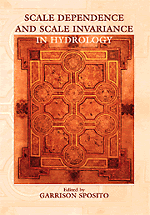Book contents
- Frontmatter
- Contents
- List of Contributors
- Preface
- 1 Scale Analyses for Land-Surface Hydrology
- 2 Hillslopes, Channels, and Landscape Scale
- 3 Scaling in River Networks
- 4 Spatial Variability and Scale Invariance in Hydrologic Regionalization
- 5 An Emerging Technology for Scaling Field Soil-Water Behavior
- 6 Scaling Invariance and the Richards Equation
- 7 Scaling of the Richards Equation and Its Application to Watershed Modeling
- 8 Scale Issues of Heterogeneity in Vadose-Zone Hydrology
- 9 Stochastic Modeling of Scale-dependent Macrodispersion in the Vadose Zone
- 10 Dilution of Nonreactive Solutes in Heterogeneous Porous Media
- 11 Analysis of Scale Effects in Large-Scale Solute-Transport Models
- 12 Scale Effects in Fluid Flow through Fractured Geologic Media
- 13 Correlation, Flow, and Transport in Multiscale Permeability Fields
- 14 Conditional Simulation of Geologic Media with Evolving Scales of Heterogeneity
- Index
1 - Scale Analyses for Land-Surface Hydrology
Published online by Cambridge University Press: 18 January 2010
- Frontmatter
- Contents
- List of Contributors
- Preface
- 1 Scale Analyses for Land-Surface Hydrology
- 2 Hillslopes, Channels, and Landscape Scale
- 3 Scaling in River Networks
- 4 Spatial Variability and Scale Invariance in Hydrologic Regionalization
- 5 An Emerging Technology for Scaling Field Soil-Water Behavior
- 6 Scaling Invariance and the Richards Equation
- 7 Scaling of the Richards Equation and Its Application to Watershed Modeling
- 8 Scale Issues of Heterogeneity in Vadose-Zone Hydrology
- 9 Stochastic Modeling of Scale-dependent Macrodispersion in the Vadose Zone
- 10 Dilution of Nonreactive Solutes in Heterogeneous Porous Media
- 11 Analysis of Scale Effects in Large-Scale Solute-Transport Models
- 12 Scale Effects in Fluid Flow through Fractured Geologic Media
- 13 Correlation, Flow, and Transport in Multiscale Permeability Fields
- 14 Conditional Simulation of Geologic Media with Evolving Scales of Heterogeneity
- Index
Summary
Introduction
This chapter discusses some research problems associated with the scaling of land-surface hydrologic processes involved in the land-surface water-and-energy budget. As pointed out by Dubayah, Wood, and Lavallee (1996), the term “scaling” has come to have multiple definitions, depending not only on the general discipline (e.g., hydrology, meteorology, geography, physics) but also on the application within a discipline. Dubayah et al. (1996) refer to a process as exhibiting scaling “if no characteristic length scale exists; i.e. the statistical spatial properties of the field do not exhibit scale-dependent behavior.” Bloschl and Sivapalan (1995) refer to scaling as the transfer of information between different spatial (or temporal) lengths. The “transfer of information” may consist in mathematical relationships, statistical relationships, or observations describing physical phenomena. This definition is consistent with that of Dubayah et al. (1996), albeit more qualitative. The term “upscaling” is often used by the remote-sensing community to describe going from observations on a small spatial (or temporal) scale to observations on larger scales, whereas “downscaling” consists in going from large-scale observations to smaller scales.
Interest in scaling as it relates to the land-surface water-and-energy budget arose from the more general problem of land-surface parameterization in climate models. In the 1970s, a series of Atmospheric General Circulation Model (AGCM) climate studies demonstrated the importance of land hydrology for the earth's climate: the sensitivity of albedo to climate (Charney et al., 1977), and the influence of soil-moisture anomalies (e.g., Walker and Rowntree, 1977).
- Type
- Chapter
- Information
- Scale Dependence and Scale Invariance in Hydrology , pp. 1 - 29Publisher: Cambridge University PressPrint publication year: 1998
- 18
- Cited by



